Guitar
Though many "vintage" types out there consider 1980 to be the absolute end of the historic Fender period, many Fender instruments from the early 80s remained essentially the same as Fenders from the 1970s. This 1981 Jazz bass is an excellent example of this - its almost indistinguishable from a 1975 through 1979 Jazz bass - grey-bottom pickups, CTS pots, tell-tale crease in the back of the bridge plate and Schaller-made "Fender" tuners. And yes - heavy as all hell !!
The real change came in 1983 when the Fullerton plant closed - all production moved to Japan for a year or so - and then the current Santa Ana plant opened to resume US building.
This bass came to me for a full-scale tuneup - it had been languishing in an attic (and maybe a basement too?) on Nantucket for the past 15 years, after being played hard for previous 12 years or so. The pretty much all original - but it had no strings, a bent tuner, a big sticker on the back, good amount of fret wear on the first 5 frets, the clear coat chipping away on the edge of the neck, rusty screws and a missing knob - and it was covered with a quarter century of grunge, such that there was a ridge around the edge of the pickguards and on all the plastic and metal components.
And it was inside a 1969 Fender case that appeared to have been slightly CRUSHED and then dunked in water to enhance its mold growing environment.
After I disassembled the bass and scraped off the Bozo the Clown sticker I began the heavy duty cleanup. Knowing that the bass had the 70s polyester indestructo finish on it - I first wet sanded the front and back with 400 grit, 600 grit and then 1000 grit paper - to get a clean smooth as possible clearcoat surface. I then compounded the entire body just as I would a refin. The end result was pretty impressive - you have to aknowledge that the polyester finishes ARE tough !!
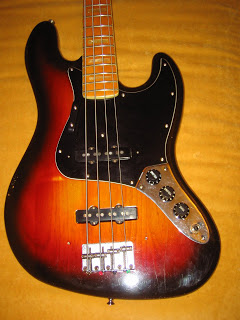
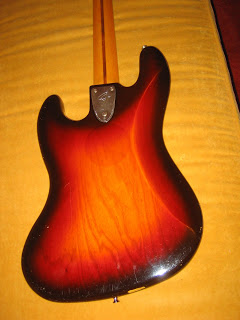
Following that came a cleanup of all the components - plastic polish for the guard and pickup covers- electronic cleaner for the pots - acetone and Brasso for the bridge and control plate. I also pulled off the bent tuner and carefully bent it back to shape - leaving a subtle crease in it, but no other damage.

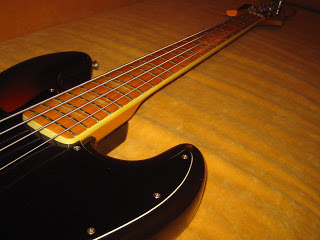
The neck was in good functional shape - with a working truss-rod - but had some heavy wear. I wet sanded off the finish on just the edges of the neck, then resprayed with ReRanch's Tinted Neck Amber to re-yellow the binding and blend everything back in. A number of the frets had come up a little, but rather than pulling them and gluing them, a few sharp taps with my fretting hammer seemed to seat them back in. I used a concave fret file once the neck was adjusted flat, to dress all the frets - checking with a straight edge to make sure none of them were high. I finished the fret with different grades of paper, using the Stew-Mac aluminum fret "masks" to protect the fretboard.
Finally - re-assembly - after tightening down the truss rod, the neck was perfectly straight - I adjusted the bridge height and then set the intonation (since I'd disassembled the bridge to clean up all the screws and saddles too).
When I plugged it in - then the trouble started - the bass sounded fine - unless I moved and then a HELLACIOUS crackling came through my amp. I checked and rechecked all the connections I'd resoldered - and switched cables - but it was still there. I finally decided to put a new output jack in - and viola! - problem solved. The output jack had no visible damage, so not sure what was going on - something I'll need to make sure I check in the future.
And then the case - which was sad. The side had started to separate and was actually bent outwards and the handle was long gone. First, I cut and pried out the mountings for the old handle, and then installed a new handle with some oversized wood screws secured with some glue.
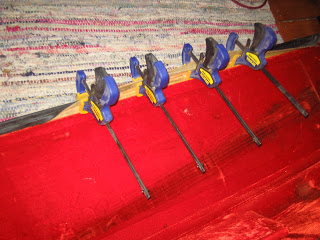
I then glued and clamped the entire side of the case after peeling back the loose Tolex and the lining. I also shot some staples in near where the original wood staples had pulled out. Once all the wood gluing was done, I used liberal amounts of Franklin hide glue to reglue the Tolex and lining, along with strategic staples and clamping by long wood strips.
All the gluing and clamping - the case was finally solid again and closed relatively well. Now to get rid of the mold !!
First I vacuumed the inside and cleaned the outside with vinyl cleaner. Then I sprayed carpet cleaner on the inside and let it dry for about an hour - then vacuumed it up. The lining was still damp after this, so I left it open and re-vacuumed it the next day - and finally it didnt smell moldy !!
A nice bass that will probably be a little better cared for in the future !!


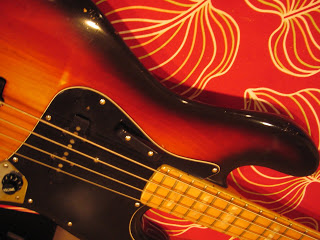
- Sold: 1972 Fender Precision (p-bass), Olympic White Refinish
SOLD!! This Fender Precision was repaired and refinished and assembled from a bunch of vintage parts I collected over time. I had always wanted to build an Olympic White with Tortoise Guard P-bass, as I think the creamy color of the aged Olympic...
- 1967 Fender Jazz Bass: Rebuilding A Water-damaged Rosewood Veneer Fretboard
I took this project on more as a challenge than as a typical repair - not sure how much I'd charge to do it again, but almost certainly A LOT more than I did in this case I'm documenting ! That being said - this repair does show the resiliency...
- For Sale: 1963 Vox Bassmaster Bass, English-made
Here is a very very rare bass from the early days of Vox/JMI - the short-scale Bassmaster. Vox began as an amplifier company in the late 1950s, based in Kent, England - but around 1961 they decided to branch out into electric guitars and basses. These...
- Sold!!: 1976 Fender Precision Bass, Olympic White
The mid-70s Fender Precision bass in Olympic White with a black pickguard was the weapon of choice for the one and only Dee Dee Ramone - I remember seeing the Ramone's countless times in New Jersey and New York - and Dee Dee had as many as three identical...
- Chemically Stripping A Guitar Body: Some Options
Usually the first step in the refinish process is removing the existing finish on the guitar. In some cases this is very easy, requiring just some sanding with a random orbital sander and a block - and other times a standard chemical stripper, such as...
Guitar
1981 Fender Jazz Bass - Last of the Fullerton Fenders
Though many "vintage" types out there consider 1980 to be the absolute end of the historic Fender period, many Fender instruments from the early 80s remained essentially the same as Fenders from the 1970s. This 1981 Jazz bass is an excellent example of this - its almost indistinguishable from a 1975 through 1979 Jazz bass - grey-bottom pickups, CTS pots, tell-tale crease in the back of the bridge plate and Schaller-made "Fender" tuners. And yes - heavy as all hell !!
The real change came in 1983 when the Fullerton plant closed - all production moved to Japan for a year or so - and then the current Santa Ana plant opened to resume US building.
This bass came to me for a full-scale tuneup - it had been languishing in an attic (and maybe a basement too?) on Nantucket for the past 15 years, after being played hard for previous 12 years or so. The pretty much all original - but it had no strings, a bent tuner, a big sticker on the back, good amount of fret wear on the first 5 frets, the clear coat chipping away on the edge of the neck, rusty screws and a missing knob - and it was covered with a quarter century of grunge, such that there was a ridge around the edge of the pickguards and on all the plastic and metal components.
And it was inside a 1969 Fender case that appeared to have been slightly CRUSHED and then dunked in water to enhance its mold growing environment.
After I disassembled the bass and scraped off the Bozo the Clown sticker I began the heavy duty cleanup. Knowing that the bass had the 70s polyester indestructo finish on it - I first wet sanded the front and back with 400 grit, 600 grit and then 1000 grit paper - to get a clean smooth as possible clearcoat surface. I then compounded the entire body just as I would a refin. The end result was pretty impressive - you have to aknowledge that the polyester finishes ARE tough !!
Following that came a cleanup of all the components - plastic polish for the guard and pickup covers- electronic cleaner for the pots - acetone and Brasso for the bridge and control plate. I also pulled off the bent tuner and carefully bent it back to shape - leaving a subtle crease in it, but no other damage.
The neck was in good functional shape - with a working truss-rod - but had some heavy wear. I wet sanded off the finish on just the edges of the neck, then resprayed with ReRanch's Tinted Neck Amber to re-yellow the binding and blend everything back in. A number of the frets had come up a little, but rather than pulling them and gluing them, a few sharp taps with my fretting hammer seemed to seat them back in. I used a concave fret file once the neck was adjusted flat, to dress all the frets - checking with a straight edge to make sure none of them were high. I finished the fret with different grades of paper, using the Stew-Mac aluminum fret "masks" to protect the fretboard.
Finally - re-assembly - after tightening down the truss rod, the neck was perfectly straight - I adjusted the bridge height and then set the intonation (since I'd disassembled the bridge to clean up all the screws and saddles too).
When I plugged it in - then the trouble started - the bass sounded fine - unless I moved and then a HELLACIOUS crackling came through my amp. I checked and rechecked all the connections I'd resoldered - and switched cables - but it was still there. I finally decided to put a new output jack in - and viola! - problem solved. The output jack had no visible damage, so not sure what was going on - something I'll need to make sure I check in the future.
And then the case - which was sad. The side had started to separate and was actually bent outwards and the handle was long gone. First, I cut and pried out the mountings for the old handle, and then installed a new handle with some oversized wood screws secured with some glue.
I then glued and clamped the entire side of the case after peeling back the loose Tolex and the lining. I also shot some staples in near where the original wood staples had pulled out. Once all the wood gluing was done, I used liberal amounts of Franklin hide glue to reglue the Tolex and lining, along with strategic staples and clamping by long wood strips.
All the gluing and clamping - the case was finally solid again and closed relatively well. Now to get rid of the mold !!
First I vacuumed the inside and cleaned the outside with vinyl cleaner. Then I sprayed carpet cleaner on the inside and let it dry for about an hour - then vacuumed it up. The lining was still damp after this, so I left it open and re-vacuumed it the next day - and finally it didnt smell moldy !!
A nice bass that will probably be a little better cared for in the future !!
- Sold: 1972 Fender Precision (p-bass), Olympic White Refinish
SOLD!! This Fender Precision was repaired and refinished and assembled from a bunch of vintage parts I collected over time. I had always wanted to build an Olympic White with Tortoise Guard P-bass, as I think the creamy color of the aged Olympic...
- 1967 Fender Jazz Bass: Rebuilding A Water-damaged Rosewood Veneer Fretboard
I took this project on more as a challenge than as a typical repair - not sure how much I'd charge to do it again, but almost certainly A LOT more than I did in this case I'm documenting ! That being said - this repair does show the resiliency...
- For Sale: 1963 Vox Bassmaster Bass, English-made
Here is a very very rare bass from the early days of Vox/JMI - the short-scale Bassmaster. Vox began as an amplifier company in the late 1950s, based in Kent, England - but around 1961 they decided to branch out into electric guitars and basses. These...
- Sold!!: 1976 Fender Precision Bass, Olympic White
The mid-70s Fender Precision bass in Olympic White with a black pickguard was the weapon of choice for the one and only Dee Dee Ramone - I remember seeing the Ramone's countless times in New Jersey and New York - and Dee Dee had as many as three identical...
- Chemically Stripping A Guitar Body: Some Options
Usually the first step in the refinish process is removing the existing finish on the guitar. In some cases this is very easy, requiring just some sanding with a random orbital sander and a block - and other times a standard chemical stripper, such as...
